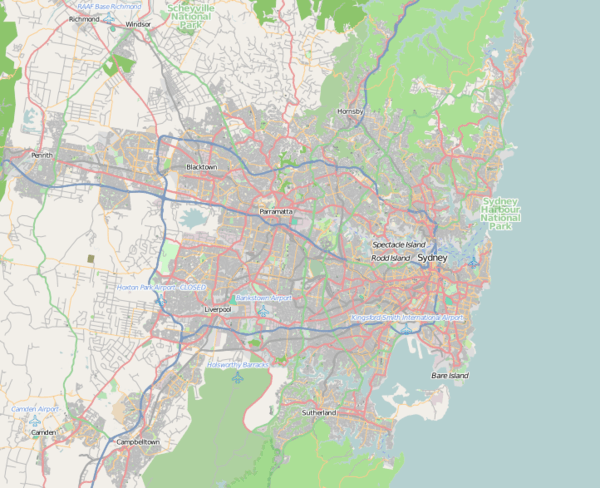Central Local Court House, Sydney
| Central Local Court House | |
|---|---|
Police_Courts_Sydney-1.jpg) | |
 Location in Greater Sydney | |
| Alternative names |
|
| General information | |
| Status | Complete |
| Type |
Court house (and former police station) |
| Architectural style | Federation Free Classical |
| Location | 98 Liverpool Street, Sydney central business district, New South Wales |
| Country | Australia |
| Coordinates | 33°52′34″S 151°12′25″E / 33.8761340331°S 151.2070821050°ECoordinates: 33°52′34″S 151°12′25″E / 33.8761340331°S 151.2070821050°E |
| Completed | 1892 |
| Owner | Government of New South Wales |
| Landlord | Department of Justice |
| Technical details | |
| Material | Sandstone; internal timber joinery |
| Design and construction | |
| Architect |
|
| Architecture firm | Colonial Architect of New South Wales |
| Website | |
| Central Court House, Sydney | |
| Official name | Sydney Central Local Court House |
| Type | Built |
| Designated | 2 April 1999 |
| Reference no. | 00802 |
| [1][2] | |
The Central Local Court House or Police Law Courts or Central Police Court is an heritage-listed building located at 98 Liverpool Street, in the central business district of Sydney, New South Wales in Australia. Constructed in the Federation Free Classical style based on original designs by Colonial Architect, James Barnet, the building structure was completed in 1892 under the supervision of Barnet's successor, Government Architect, Walter Liberty Vernon.
The court house is located in a precinct that includes the Downing Centre, and buildings housing the Family Court of Australia and the Federal Circuit Court in Sydney. Adjacent to the court house is Brickfield Place, a brick paved courtyard with seating and planter boxes, constructed in 1892, assessed as a good example of urban design for public open space.[3]
Heritage listing
On the 2 April 1999 the court house building was listed on the New South Wales State Heritage Register with the following statement of significance:[1]
The Central Local Courthouse is of State historical significance as the first purpose built Police Court with the State Justice system and first petty Sessions Court. The building is a fine and intact example of a classically inspired public building designed in the Federation Free Classical style by James Barnet, the last Colonial Architect with construction supervised by WL Vernon, the first Government Architect. The building is an example of a Court that operated in association with a Police Station and significantly has continued to operate with attached Holding Cells complex to present day.
The Central Local Courthouse and holding Cells are good examples of late nineteenth century Courthouse and prison environment that despite alterations and modification demonstrate certain design philosophies and standards of that time. The form and relationship of the Holding Cells are functional and reflect Barnet’s preference to relate each building to its site and context. The design of the Courthouse and its principle façade connotes typical characteristics of this type of building. The buildings remain as a good and intact example of a Courthouse and associated facilities designed by the Colonial Architects Office and that demonstrate the growing affluence and prosperity of the time.
Central Local Courts and Holding Cells are of social significance for their on-going association with the police, Attorney general’s Department, Department of Corrective Services, NSW Sherriff’s office and all associated parties who have used the building for over 100 years. The building significantly continues to operate and is part of a network of Courts in the local area.
— Statement of significance, New South Wales State Heritage Register.
See also
References
- 1 2 "Sydney Central Local Court House". New South Wales State Heritage Register. Office of Environment and Heritage. Retrieved 15 October 2017.
- ↑ "Central Police Courts (Place ID 2194)". Australian Heritage Database. Department of the Environment. Retrieved 15 October 2017.
- ↑ "Brickfield Place". New South Wales State Heritage Register. Office of Environment and Heritage. Retrieved 31 October 2017.
Attribution
![]()
External links
| Wikimedia Commons has media related to Central Court, Sydney. |